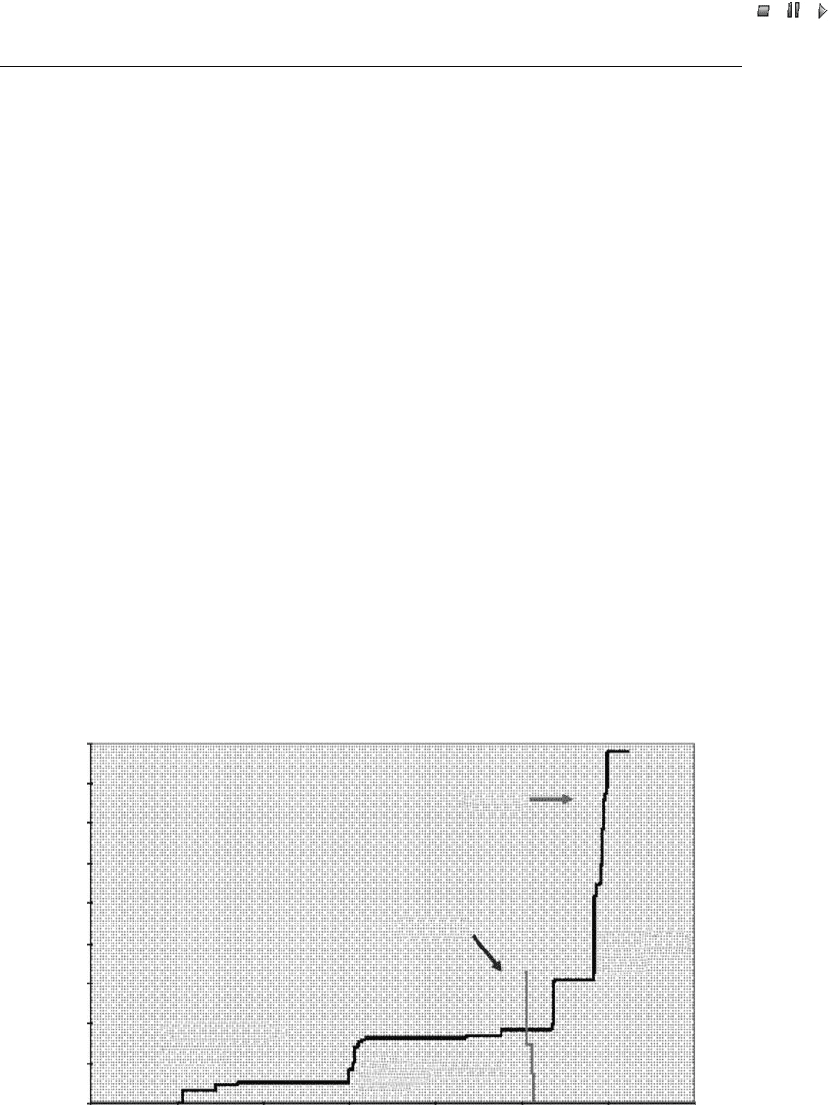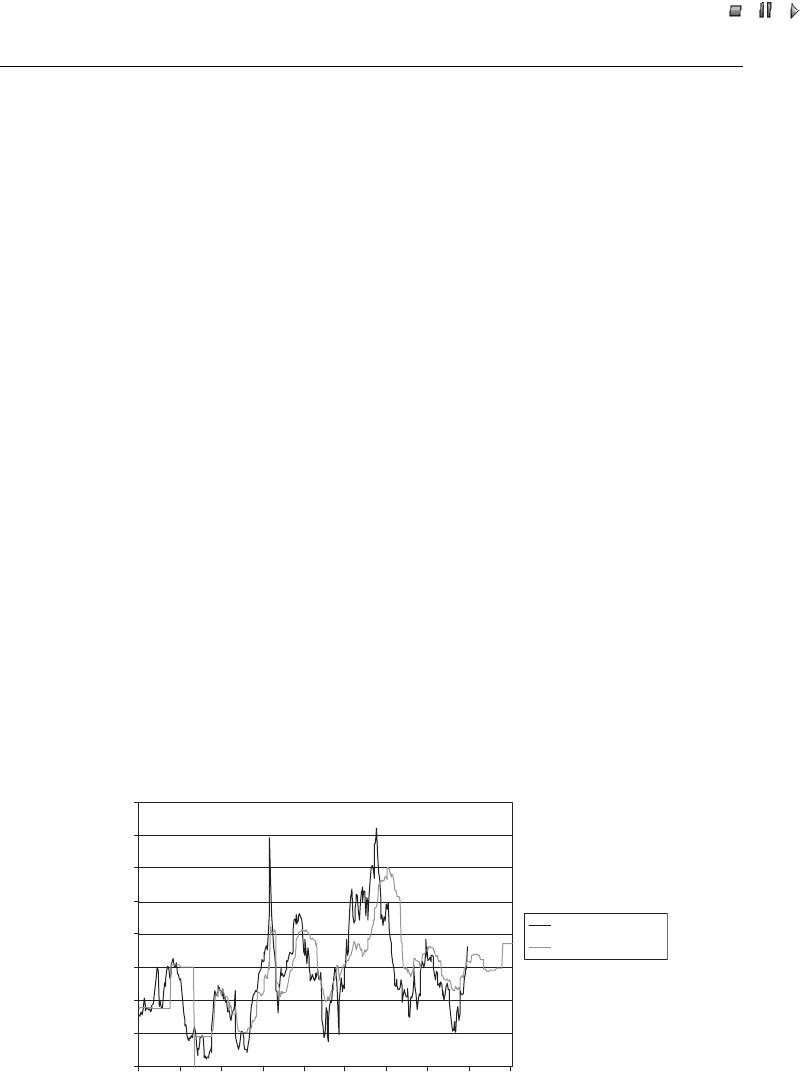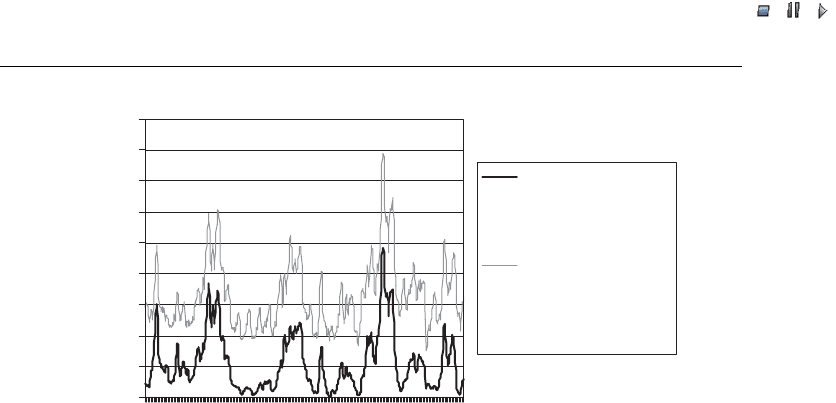AckermannTh. (ed) Wind Power in Power Systems
Подождите немного. Документ загружается.


//INTEGRAS/KCG/P AGIN ATION/ WILEY /WPS /FINALS_1 4-12- 04/0470855088_ 19_CHA18 .3D – 391 – [383–410/28]
17.12.2004 10:41PM
18.3.1 Primary control issues
As explained in Chapter 3, the impact of wind power on short-term (i.e. minute-by-
minute) frequency variations is usually considered to be low. The sometimes significant
power output variations of a single wind turbine are smoothed significantly if a large
number of wind turbines are aggregated (see Figure 3.7, page 37). Hence, it is usually very
difficult to allocate precisely primary control costs directly to wind power or any other
network customer, as production or demand is not measured on a minute-by-minute basis.
Primary control is usually performed by frequency-sensitive equipment, mainly syn-
chronous generators in large power plants. They will increase production when fre-
quency decreases or will reduce production when frequency increases. If the frequency
drops below a certain threshold, a special capacity that is reserved for primary control,
known as primary control capacity or primary reserves, will be used.
A commonly asked question is whether wind power increases the need for primary
control capacity and thus causes additional costs. Experience shows that under normal
operating conditions wind power does not increase the need for primary control capa-
city. The maximum wind gradient per 1000 MW installed wind capacity observed in
Denmark and Germany is 4.1 MW per minute increasing and 6.6 MW per minute
decreasing (see also Table 9.1, page 175).
(4)
In the power system in Western Denmark,
the primary control capacity is activated in the case of a frequency deviation of
200 mHz, corresponding to a significant loss of production (around 3000 MW) within
the UCTE (Union pour la Coordination du Transport d’Electricite
´
) system. Based on
the UCTE definition, Western Denmark requires a primary control capacity of 35 MW.
This primary control capacity has not been increased over past years, despite a sig-
nificant increase in the average wind power pe netration over the past 10 years from
almost 0 % to more than 18 % (see Chapter 10).
A need for additional primary control capacity can, however, arise if a larger number
of wind turbines disconnect from the network within a comparatively short time. We
can imagine two situations that can cause such an effect. The first case occurs if a storm
with very high wind speeds approaches a large number of wind turbines with similar
cutoff behaviour. If, in this case, the wind speed exceeds the cutoff wind speed the
affected wind turbines will all shut down almost simultaneously. In Denmark and
Germany, such high wind speeds occur only a few times a year and, owing to the large
number of different turbines, no ‘instant’ shutdown of a large number of wind turbines
that may require additional primary control capacity has been observed.
(5)
The impact
might be different in other countries, for instance in locations with very high wind
speeds, for example, New Zealand, where the wind speed exceeds the cutoff wind speed
approximately every three to four days, and/or in areas with very large wind farms with
similar cutoff behaviour. In such situations, additional primary control capacity might
be required. A possible solution would be the installation of wind turbines with different
(4)
In Germany and Denmark wind power is geographically well distributed. In the case of a large wind power
project at a single location, the wind gradient can be significantly higher.
(5)
The largest wind power decrease observed in the E.ON network in Germany as a result of high wind speeds
was approximately 2000 MW. The disconnection, however, was not instantaneous, but occurred over approxi-
mately 5 hours.
Wind Power in Power Systems 391

//INTEGRAS/KCG/P AGIN ATION/ WILEY /WPS /FINALS_1 4-12- 04/0470855088_ 19_CHA18 .3D – 392 – [383–410/28]
17.12.2004 10:41PM
cutoff behaviour, for instance, using a linear power reduction instead of a sudden
shutdown of the wind turbine (for details, see Chapter 3). This way, the costs for
possible additional primary control capacity can be avoided.
The second case occurs when a network fault causes frequency or voltage variations
which lead to the disconnection of a very large number of wind turbines during times
with high wind speeds (i.e. during times with high wind power production). New grid
codes, however, require that wind turbines are able to stay connected to the network
during certain faults (fault ride-through capability; see Chapter 7). Hence the likelihood
of such situations is considerably reduced as a result of the new grid codes.
In summary, it is hardly possible clearly to determine the co sts that wind power might
cause regarding primary control. To reduce the likelihood of addition al costs for
primary control capacity caused by wind power, a certain shutoff behaviour for wind
turbines can be required and/or new grid codes can be implement ed. Whether this leads
to the best overall economic solution depends very much on the specific case. As
mentioned in Chapter 7, fault ride-through capability may increase the investment co sts
for wind turbines by up to 5 %. In power systems with sufficient primary control
capacity, such additional investment costs may not be economically justified.
18.3.2 Treatment of system operation costs
Here, system operation costs are defined as the costs that are independent of network usage
but that are essential for reliable system operation. Such costs are related to primary control
and primary control capacity, black-start costs and investments in system robustness. The
primary control costs are included because they can usually not be linked to any market
participant. System operation costs should in principal be divided between all power system
users based on their network usage, e.g. transmitted energy (kWh).
In some countries (e.g. England and Wales, and Australia) wind power is currently
not required to contribute to these costs. Similar to the case of ne twork upgrade costs, it
can be argued that wind power is a measure to create a sustainable energy supply from
which all market participants gain. Hence, these costs should be covered by market
participants, excluding wind power generation.
The English and Welsh regulator Ofgem, however, concluded that such treatment
may be considered unfair. Hence Ofgem is currently considering the implementation of
a new tariff system that requires wind farms to contribute to the system operation costs
(Ofgem 2003).
18.3.3 Secondary control issues
If there is an imbalance between generation and consumption, the primary control will
jump into action to reduce the imbalance. This means that primary control reserves
will be partly used up after the imbalance is restored and/or that the primary control will
reduce the imbalance but the restored frequency will deviate from 50 Hz or 60 Hz.
Secondary control is then used to solve this problem by freeing up capacity used for
primary control and moving this required capacity under a secondary control regime
(for an illustration, see Figure 8.3, page 148). Secondary control capacity should usually
392 Economic Aspects

//INTEGRAS/KCG/P AGIN ATION/ WILEY /WPS /FINALS_1 4-12- 04/0470855088_ 19_CHA18 .3D – 393 – [383–410/28]
17.12.2004 10:41PM
be available within 15 minutes notice. Hence, any difference between forecasted wind
power production and actual wind power production is essentially allocated to second-
ary control capacity.
The figures in Table 9.1 (page 175) may be used to illustrate this. The maximum wind
gradient per 1000 MW installed wind capacity observed in Denmark and Germany was
6.6 MW per minute decreasing. In such an extreme event the primary control must
provide 6.6 MW per minute of additional capacity per 1000 MW of wind power to keep
the defined frequency. This is usually not a pro blem and often amounts to less than load
variations. However, if the wind power production decreases with this maximum
gradient for 15 minutes, the requirements for primary control add up to almost
100 MW (15 min 6:6 MW per min) per 1000 MW of installed wind power capacity.
Secondary control will then start to free up the capacity used for primary control, which
might be required if wind power production continues to decrease.
The demand on secondary control depends on the wind power production forecast
error (i.e. the difference between the forecasted wind power production and the actual
wind power production). The wind power production forecast error depends partly on
the time span between the wind power forecast and actual production. That means that
a forecast for wind power production 5 minut es prior to production will be more precise
than a forecast 1 hour prior to production. In deregulated markets, the closing time of
the power exchange defines the time of the last wind power production forecast that is
possible (i.e. the closing time influences the foreca st error and therefore the wind power
related costs for secondary control).
Table 18.3 provides an overview of market closing times in different electricity
markets. It should be noted that the mainly hydro based market power exchange (PX)
Elspot in Scandinavia has a market closing time of 12 to 36 hours before actual delivery,
despite the fact that a significan t share of power generation is based on hydro powers
which does not need such a long planning horizon or startup time. The Australian
market, with a power generation mix that is based mainly on coal power, which can be
considered rather inflexibl e in terms of startup times, allows rebidding until 5 minutes
prior to actual delivery.
Table 18.3 Market closing times in various electricity markets
Market Closing time
England and Wales 1 hour before the half-hour in question
Nord Pool Elspot
(power exchange)
12:00 p.m. before the day in question; no changes
possible after 12:00 p.m.
Nord Pool Elbas 1 hour before the hour in question; no changes possible
after this
Australia power exchange Rebidding possible until the resources are used for
dispatch (i.e. up to 5 minutes before the time in
question)
New Zealand power exchange 2 hours before the hour in question
PJM Market day-ahead market 12:00 p.m. before the day in question; no changes
possible after 12:00 p.m.
Wind Power in Power Systems 393

//INTEGRAS/KCG/P AGIN ATION/ WILEY /WPS /FINALS_1 4-12- 04/0470855088_ 19_CHA18 .3D – 394 – [383–410/28]
17.12.2004 10:41PM
The Elbas market can be seen as a supplement to Nord Pool’s Elspot. Owing to the
lengthy time span of up to 36 hours between Elsp ot price fixing and delivery, partici-
pants can use Elbas in the intervening hours to improve their balance of physical
contracts. Elbas offers continuous trading up to 1 hour before delivery; however, the
Elbas market can be used only by Swedish and Finish market participants and not by
participants from Denmark.
The problem of long market closing times became particularly evident with the intro-
duction of the New Electricity Trading Arrangement (NETA) in England and Wales in
March 2001. Within NETA, wind power generators are forced to pay the imbalance costs
between predicted wind power production and actual production. NETA first had a
market closing time of 3.5 hours before the time of delivery. Hence, wind power gen-
erators had to pay for any imbalance between the wind power production that was
predicted 3.5 hours prior to delivery and actual delivery. As a result, revenue for wind
power generators fell by around 33 % (Massy, 2004). The market closing time was then
reduced from 3.5 hours to 1 hour, which resulted in a significantly lower exposure to
additional imbalance costs for wind power generators. Discussions with wind farm
operators that operate several wind farms in England and Wales revealed that, now, wind
power generators usually bid the actual aggregated wind power production measured 1
hour before the time of delivery into the PX. For large wind power generators, with a
number of wind farms distributed over the country, the aggregation of the wind farms
significantly reduces the possible imbalance within one hour. Hence, wind farm operators
with a large number of wind farms consider the imbalance costs to be acceptable.
For wind power generators with a single wind farm the issue is different, as the
geographical smoothing effect between different locations is smaller and hence vari-
ations between forecasted production and actual production can still be significant. It
can, of course, be argued that those who cause the imbalance should also pay for
keeping the balance. However, this will not result in an overall economically optimum
solution. As mentioned before, power fluctuations from wind generation depend on the
number of wind turbines. For wind turbines distributed over a large geographic area,
fluctuations are reduced by 1/
ffiffiffi
n
p
, where n is the number of wind turbines. If all wind
turbines in one power system are owned by the same market participant, the sum of all
imbalance costs would be approximately 1/
ffiffiffi
n
p
lower than for a large number of wind
turbines being owned by different, independent owners wher e each owner pays the
imbalance costs for each turbine. Hence, if all wind turbine owners pay individually,
they pay together for a significantly higher total imbalance than they cause (the details
depending very much on how the imbalance costs are determined). Therefore, advocates
of wind power argue that a power system was built to aggregate generation and demand
whereas individual imbalance pricing is reversing this by disaggregating generation in
the name of competition.
A possible solution to this problem is to consider all independent wind farms as one
generation source and divide the total imbalance costs caused by this aggregated wind
farm between the different wind farm owners.
In summary, the approach for wind power imbalance pricing should consider the
flexibility in a power system (i.e. the time required to start up or adjust generation
sources). This time will vary according to the power generation mix in each power
system as well as on the wind power penetration. Hence, the wind power imbalance
394 Economic Aspects

//INTEGRAS/KCG/P AGIN ATION/ WILEY /WPS /FINALS_1 4-12- 04/0470855088_ 19_CHA18 .3D – 395 – [383–410/28]
17.12.2004 10:41PM
costs depend very much on the overall design of the electricity market and on the
approach to power system operation.
18.3.4 Electricity market aspects
Power system integrati on costs are usually discussed in relation to integration costs in
the power system but seldom in combination with integration costs and benefits to the
electricity market.
An important instrument of the electricity market is the PX. The PX defines a single
market clearing price for each trading period. This single market price is the intersection
where the marginal costs of the producer equals the price the last consumer is willing to
pay (the equilibrium price). If there is a perfect competitive market, every power generator
would bid with its short-run production costs, also known as marginal costs. These
marginal costs usually represent the fuel costs for keeping the power unit(s) in operation
for another time period. Wind power, however, has no fuel costs. Hence, wind power will
always bid into the market with very low or zero costs to be able to operate whenever the
fuel source, ‘wind’, is available. This can have the following two implications for the PX:
.
Independent wind power generators may reduce the incentives for large generation
companies to exercise market power; hence wind power may increase the overall
economic efficiency of power markets (this conjecture is substantiated in Ackermann,
2004).
.
If wind power production dominates the electricity market, it may be difficult for the
market to reach an equilibrium between demand and supply. Hence the system operator
may not be able to match demand and supply, which is required for secure operation of
the power system. This aspect is discussed in more detail in the next section.
18.4 Example: Nord Pool
In the following, the impact of wind power in Denmark on the PX in Scandinavia, Nord
Pool’s Elspot, and on the balancing market, which is a part of the secondary control, is
discussed in more detail.
The Nord Pool power exchange is geographically bound to Norway, Sweden, Finland
and Denmark. The market was established in 1991 and, until the end of 1995, the
electricity exchange covered Norway only. In 1996, Sweden joined the exchange and the
name was changed to Nord Pool. In 1998, Finland was included, and in 1999–2000
Denmark joined.
(6)
The market is at present dominated by Norwegian and Swedish
hydro power, though power trade with neighbouring German markets increases and
thereby reduces the dominance of hydro power. Because Denmark is situated between
(6)
Within Nord Pool, Denmark is separated into two independent parts covering the Western Denmark area
(the Jutland–Funen, or Eltra, area) and the Eastern Denmark area (the Zealand, or Elkraft, area), including
the small neighbouring islands. These two parts do not have a direct electrical connection and therefore
constitute two specific pricing areas in the market.
Wind Power in Power Systems 395

//INTEGRAS/KCG/P AGIN ATION/ WILEY /WPS /FINALS_1 4-12- 04/0470855088_ 19_CHA18 .3D – 396 – [383–410/28]
17.12.2004 10:41PM
the large conventional fossil fuel based power systems of central Europe (especially
Germany) and the hydro-dominated Nordic system, Denmark is a kind of buffer
between these systems. This implies that the power price in Denmark relates partly to
the Nordic market and partly to the German market, depending on the situation in these
markets.
18.4.1 The Nord Pool power exchange
The Nord Pool PX Elspot is a daily market in which the price of power is determined by
supply and demand. Power producers and consumers submit their bids to the market
12–36 hours in advance, stating quantities of electricity supplied or demanded and the
corresponding price. Then, for each hour, the price that clears the market (equalises
supply with demand) is determined at the Nord Pool PX. In principle, all power
producers and consumers are allowed to trade at the exchange but, in reality, only big
consumers (distribution and trading companies and large industries) and generators act
on the market, with the small ones forming trading cooperatives (as is the case for wind
turbines) or commissioning larger traders to act on their behalf. A minor part of total
electricity production is actually traded at the spot market. The majority is sold on long-
term contracts, but the spot prices have a considerable impact on prices in these
contracts.
Figure 18.3 shows a typical exampl e of an annual supply and demand curve for the
Nordic power system. As shown, the bids from hydro and wind power enter the supply
curve at the lowest level owing to their low marginal costs, followed by combined heat
and power (CHP) plants; condensing plants have the highest marginal costs of power
800
90
80
70
60
50
40
30
20
10
0
0 200 400 600 1000 1200 1400
TWh
Wind and hydro
power
Demand
Supply
Condensing
plants
Combined heat and
power
Norwegian øre per kWh
Figure 18.3 Supply and demand curve for the Nord Pool power exchange
396 Economic Aspects

//INTEGRAS/KCG/P AGIN ATION/ WILEY /WPS /FINALS_1 4-12- 04/0470855088_ 19_CHA18 .3D – 397 – [383–410/28]
17.12.2004 10:41PM
production. In general, the demand for power is highly inelastic, with mainly Norwegian
and Swedish electroboilers and power-intensive industry contributing to price elasticity
in power demand.
If the trade of power can flow freely in the Nordic area (i.e. if there is no congestion of
transmission lines between the areas) there will be only one price in the market, but if the
required power trade cannot be handled physically because of transmission constraints,
the market will be split into a number of submarkets. The pricing areas define these
submarkets; for example, Denmark is split into two pricing areas (Jutland–Funen and
Zealand). Thus, if the Jutland–Funen area produces more power than consumption and
transmission capacity covers, this area would constitute a submarket, where supply and
demand would be equalised at a lower price than that at the general Nord Pool market.
18.4.2 Elspot pricing
In a system dominated by hydropower, the spot price is heavily influenced by the
precipitation in the area. This is shown in Figure 18.4, where the price ranges from a
maximum of NKr350 per MWh (approximately E42 per MWh) to almost zero. Thus,
there were very wet periods during 1992 and 1993 and, similarly, although to a lesser
extent, in 1995 and 1998. Dry periods dominated in 1994 and at the beginning of 1995.
In 1996, there was a long period with precipitation significantly below the expected level.
Looking more closely at the last two years, prices have been fairly stable (see Figure
18.5), with the exception of the end of 2002 and early 2003. The average price in 2001
and 2002 was approximately E25 per MWh, ranging from E15 per MWh to E100 per
MWh. But in 2002 the autumn was very dry in both Norway and Sweden, and this
heavily affected the prices in October, November and December 2002 as well as in
January 2003. Thus, excluding the last three months of 2002 from the considered period,
0
50
100
150
200
250
300
350
400
Year
Spot price
Expected price
1991
1992
1993
1994
1995
1996
1997
1998
1999
Price (NKr)
Figure 18.4 Price of power in the Nordic market for the period 1991–1999, in Norwegian krone
(NKr). Note: the labels on the year axis represent January of the given year
Wind Power in Power Systems 397

//INTEGRAS/KCG/P AGIN ATION/ WILEY /WPS /FINALS_1 4-12- 04/0470855088_ 19_CHA18 .3D – 398 – [383–410/28]
17.12.2004 10:41PM
the price ranged from E15 per MWh to E33 per MWh. But the draught in Norway and
Sweden meant that prices rose to a high of more than E100 per MWh, and power prices
in the Nordic market did not return to normality before Spring 2003 owing to the
importance of hydro power. But high prices are only part of the abnormality in the
present power market .
As shown in Figure 18.5, the system price and the two area prices for Denmark West
and East, respectively, are normally closely related, implying that congestion in the
transmission system seldom has a major impact upon price determination. But this close
relationship seemed to have vanished by the end of 2002 and early 2003, when prices in
the Western Danish area differed quite considerably from system prices, mainly owing
to the high level of wind power penetration in this area. This phenomenon will be
investigated in more detail below.
18.4.3 Wind power and the power exchange
In relation to the power system, wi nd power has two main characteris tics that signifi-
cantly influence the functioning of wind power in the system:
.
Wind power is an intermittent energy source that is not easy to pred ict. The daily and
weekly variations are significant, which introduces high uncertainty in the availability
of wind-generated power even within relatively short time horizons.
.
Wind power has high up-front costs (investment costs) and fairly low variable costs.
Because part of the variable costs consists of annual fixed expenses, such as insurance
and regular maintenance, the marginal running costs are seen to be even lower.
0
100
200
300
400
500
600
700
800
900
1
9
17
25
33
41
49
5
13
21
29
37
45
1
Price (DKr/MWh)
Denmark West
Denmark East
System
2001 2002 2003
Week
Figure 18.5 Power prices at the Nord Pool market in 2001, 2002 and early 2003: weekly average
(exchange rate 1 E ¼DKr7:45)
Source: Nord Pool, 2003
398 Economic Aspects

//INTEGRAS/KCG/P AGIN ATION/ WILEY /WPS /FINALS_1 4-12- 04/0470855088_ 19_CHA18 .3D – 399 – [383–410/28]
17.12.2004 10:41PM
Bearing these two main characteristics in mind, a number of questions arise when wind
power is introduced into a liberalised market:
.
How much wind power can be introduced into a power exchange wi thout jeopa rdising
the overall functioning of the power exchange and the system operation?
.
How will wind power influence the price at the power spot market in the short and
long term?
.
What is the need for secondary control from wind plants in relation to the time from
gate closure to real-time dispatch?
.
What is the cost of wind power when it fails to fulfil its bid to the market (i.e. the cost
of regulating wind production in the system)?
We will try to answer these questions in what follows by using the experience gained in
Denmark, especially in relation to the power system of Western Den mark. This area has
been chosen because it has a number of specific characteristics, some of them related to
wind power:
.
It has a very large share of wind-produced energy – in 2002, around 18 % of total
power consumption was covered by wind power (see also Chapter 10). Presently, most
of wind-generated power is covered by prioritised dispatch, hence the system operator
must accept wind power production at any time.
.
It has a large share of de centralised CHP, which is paid according to a three-level
tariff and is also covered by prioritised dispatch.
.
It lies at the border between the fossi l fuel based German power system and the hydro
power dominated Nordic system and thus is heavily affected by both areas.
In 2002, there were around 2300 MW of wind power in the Western Denmark power
system and thus wind power has a significant influence on power generation and prices.
18.4.3.1 The share of wind power in the power exchange
How much wind power can be introduced into a power exchange without jeopardising
the overall functioning of the power exchange and the system operation? In the follow-
ing, this que stion will be further investigated using a small case study carried out on the
Western part of Denmark.
Figure 18.6 illustrates for December 2002 the share that wind-generated electricity
had in relation to total power consumption in the Jutland–Funen area. In total, 33 % of
domestic electricity consumption in this area was supplied by wind power in that month.
As shown in Figure 18.6, in December 2002 the share of wind-generated electricity in
relation to total power consumption in the Jutland–Funen area reached almost 100 % at
certain points in time. That means that in this area all power consumption at that time
could be supplied by wind power. A large part of the power generated by wind turbines
is still covered by priority dispatch in Denmark, and this is also the case for power
produced by decentralised CHP plants . This implies that these producers do not react to
the price signals from the spot market – wind producers under priority dispatch are paid
Wind Power in Power Systems 399

//INTEGRAS/KCG/P AGIN ATION/ WILEY /WPS /FINALS_1 4-12- 04/0470855088_ 19_CHA18 .3D – 400 – [383–410/28]
17.12.2004 10:41PM
the feed-in tariff for everything they produce, whereas decentralised CHP plants are
paid according to a three-level tariff, highest during the day and lowest at night. Thus,
CHP plants will only produce at the low tariff if there is a need to fill up the heat storage.
In December 2002, total prioritised production exceeded domestic power demand
during several hours, requiring power to be exported and thus adding to the problem of
congestion of transmission lines.
The consequences are clearly shown in Figure 18.7, which depicts deviations between
the Nord Pool system price and the realised price in Western Denmark. The Western
Denmark price is significantly lower than the system price for a large number of hours.
Note that the power price in Western Denmark becomes lower than the system price if
transmission lines from the area are utilised entirely for exporting power but supply still
exceeds demand, forcing conventional power plants to reduce their load. Thus, during
such situations, the Western Denmark power system is economically decoupled from the
rest of the Nordic power market and constitutes a separate pricing area, where it has to
manage on its own. The conventional power plants have to reduce their production until
equilibrium between demand and supply is reached within the area. The consequence is
that the price of power is also reduced. If power production cannot be reduced as much
as required, a system failure or even breakdown might result. That the power price in the
Western Denma rk area becomes zero during a number of hours is a clear indication of
the pressure put upon the power system.
Nevertheless, although the power system in Western Denmark sometimes has been
under pressure, there have been no system failures due to too much wind power in the
system. Thus it has been possible for the system operator to handle these large amounts
of wind and decentralised CHP. In the future, the prioritised status of decentralised
CHP plants is expected to be changed, moving these to act on the power market as other
conventional power plants. In that case, an even higher share of wind power might be
accepted in Western Denmark.
0.0
20.0
40.0
60.0
80.0
100.0
120.0
140.0
160.0
180.0
1
79
157
235
313
391
469
547
625
703
Hours in December 2002
Wind power as a
percentage of
domestic power
consumption
Wind power and
decentralised power
as a percentage of
domestic power
consumption
Power (%)
Figure 18.6 Wind-generated power and decentralised power as percentage of total power con-
sumption on an hourly basis in December 2002 for the Jutland–Funen area of Denmark
400 Economic Aspects
